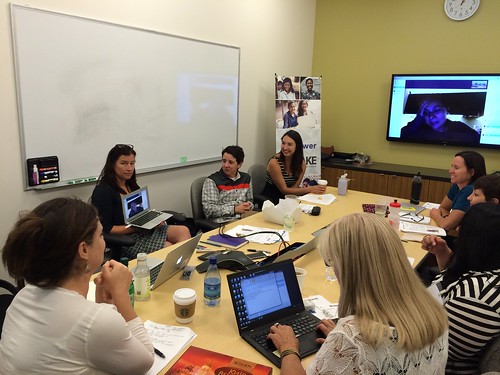Last week, I facilitated a peer learning session for Emerging Nonprofit Leaders and their mentors about healthy and productive meetings. We covered the best practices of meetings, both face-to-face and virtual meetings. I’ve been reflecting on the discussion we had about how meetings are “under belly” of an organization’s culture and ways to make incremental changes to improve meeting culture to avoid wasting time or frustration.
Since many of the participants were from organizations that worked with networks or many partners or had affiliates in different places of the world, many of their meetings tended to be hybrid meetings. A common scenario is where the majority of meeting participants in one location, a conference room, and are trying to collaborate with a handful of invisible partners on the other end of phone line or video conference call. How do we ensure that there is equal participation between those who are participating virtually and those in the room together?
Unfortunately, the remote participants feel disconnected and get distracted during the meeting, and the people in the room forget the remote people are there at all. This can happen even if your organization is using video conferencing.
Recently, I read about an exercise that you can do to intentionally improve the experience for all. The exercise teaches empathy. Of course, improving the experience and productivity of the meeting would have to be a goal for everyone involved because you’d be allocating some meeting time to improving the process versus reports or decision-making.
It’s simple. Put a blindfold on someone in the main location. Even better, pass the blindfold around the room until everyone has had the opportunity to spend few minutes in darkness. That means everyone – the facilitator, note taker, and even the senior manager.
The idea of this exercise is to foster empathy for remote participants who can’t see everything that going on or everyone’s faces. And if the quality of the audio is bad, can’t hear everything well. This direct experience will help everyone understand what it is like to be at meeting and not being able to see or having our ability to understand or participate in the conversation restricted.
At the end of the meeting, you facilitate a brief reflection on what it was like – was it disruptive? Did reduce our effectiveness? If that is the case, we could ask ourselves why we spend out time on ineffective meetings in the first place?
Two simple tips will help in hybrid meetings.
First, contact those who will be present through the phone beforehand to discuss how they will participate. Warn them explicitly about background noise and not putting the call line on hold. And let them know that they will be called on to participate.
Second, assign someone in the room to be the “bridge facilitator.” His or her role will be to connect the people on the phone or online via a computer with the people in the room, making sure they get called on and acknowledged throughout the meeting. They would also make sure that the camera on the video conferencing system is moved around so the remote person can see the person who is talking.

In a few weeks, I’ll be facilitating a training in the Ukraine with Wake International. As part of the curriculum development, we needed to have meetings with our trainers, some who are here in the US, but also with our partners in the Ukraine and one from Poland. We brought our remote partners into the room via Skype. We had assigned a bridge moderator, but we also made sure that we positioned the laptop so the remote person could see our faces. The bridge moderator moved the laptop with the camera to focus on the person speaking, so the remote person could see them.
If your organization has meetings with remote participants, even if you use video conferencing, think about how you improve the experience so all can be engaged. The bottom line is that we work best when we are all engaged, when everyone makes an effort to ensure everyone else can contribute. We are more productive in meetings when nobody is left out and all involved have empathy for each other. Doing an exercise that increases empathy can be the first step in improving your virtual meeting.
How does your organization make sure that your virtual meetings are effective?
Beth Kanter is a consultant, author, influencer. virtual trainer & nonprofit innovator in digital transformation & workplace wellbeing.

Leave a Reply